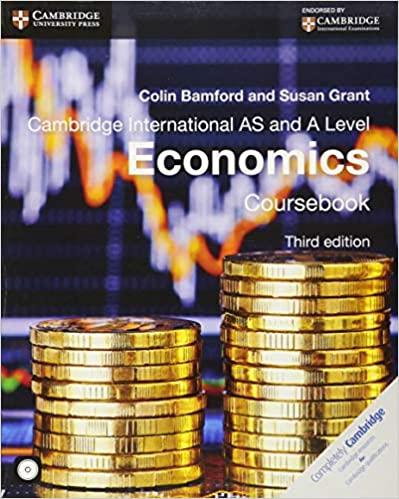Question
1. a)[10 points] Assume that the U.S. real GDP in 2010 was $13,000 billion (in year-1990 dollars). In 1990, real GDP was $8,000 billion (in
1.
a)[10 points] Assume that the U.S. real GDP in 2010 was $13,000 billion (in year-1990 dollars). In 1990, real GDP was $8,000 billion (in year-1990 dollars). a) Use the compound growth formula to compute the average annual growth rate of real GDP from 1990 and 2010. Answer:____________________________
b) If the $13,000 billion in 2010 was actually in the year 2010 dollars and the price index that year was 150 (with the index in 1990, the base year, equal to 100), what was the actual average annual growth rate of real GDP between 1990 and 2010?
Answer:____________________________
2. Consider a simple closed economy in which there are only two firms, FlourCo and PastaCo. In the year 2000, FlourCo sells 0.5 million pounds of flour to PastaCo and 2 million pounds of flour to households. PastaCo uses all of the flour it purchases to produce pasta and sells all 0.25 million pounds of pasta it produces to households. In 2000, the price of flour was $1 per pound and the price of a pound of pasta was $2.00. Compute GDP using the production-side method.
Answer:____________________________
3.Suppose the U.S. Treasury sells a bond with a three-year maturity, a principal of $100, and a coupon rate of 15%. A Cambridge bank buys this bond. If the bank manager decides to sell the bond after one year (after it receives the first coupon payment), when the market interest rate is 10%, what is the most she can expect to get for the bond?
Answer:____________________________
4. a)In no more than 3 lines, please provide any two of the three properties of GOOD institutions as proposed by Daron Acemoglu in his short paper.
Answer: ________
b) In no more than 3 lines, what is the definition of household "wealth"? How is it different from household "savings"
Answer: ____________
5. Diagram of saving and investment in an open economy.
a) Draw and carefully label a diagram of the supply of saving and demand for investment in the United States, an open economy. On your diagram, draw and label the demand for investment curve, the supply of national saving curve, and the curve representing the total supply of saving available to finance investment in the U.S. No explanations required.
b) Suppose that the price of capital goods suddenly increases sharply in the United States. Illustrate what effect this would have on a diagram like the one you drew for part (a). No explanation required, just carefully label your diagram.
State what effect the event described in part (b) would have on each of the following in the U.S. in equilibrium: No explanations or diagrams required. Just indicate the direction (i.e. more/greater or less/lower) of change for each one.
The quantity of investment Answer:_____________________________
The real interest rate Answer:_____________________________
The value of Net capital inflows Answer:_____________________________ (not the curve itself)
The value of Net Exports Answer:_____________________________
6.) Answer True or False.
a)An increase in a government's budget deficit will crowd out private investment in the economy. True False
b) Skill-biased technological change has worked to increase inequality in the United States over the last 30 years. True False
c) According to the efficient markets hypothesis, the average investor can construct a welldiversified portfolio whose returns easily beat the performance of the overall stock market. True False
d) When technological ideas cannot easily flow between firms, the incentive for each individual firm to invest in R & D is greater than when ideas can flow easily between firms.
Step by Step Solution
There are 3 Steps involved in it
Step: 1

Get Instant Access to Expert-Tailored Solutions
See step-by-step solutions with expert insights and AI powered tools for academic success
Step: 2

Step: 3

Ace Your Homework with AI
Get the answers you need in no time with our AI-driven, step-by-step assistance
Get Started


